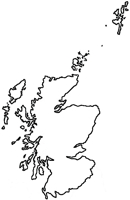
|
The Society of Folk Dance Historians (SFDH)
Scottish Step Dancing
[
Home |
About |
Encyclopedia | CLICK AN IMAGE TO ENLARGE |

|
 Although Scottish "step dancing" includes the "Highland" dances, as used today, the term usually refers to non-Highland or "National" dances, as well as Scottish Ladies' Step Dances. The five modern Highland dances are the Highland Fling, Sword, Seann Truibhas, Strathspey & Reel, and Reel of Tulloch. Thus, the great majority of Scottish dances other than Highland and Scottish Country dances are step dances.
Although Scottish "step dancing" includes the "Highland" dances, as used today, the term usually refers to non-Highland or "National" dances, as well as Scottish Ladies' Step Dances. The five modern Highland dances are the Highland Fling, Sword, Seann Truibhas, Strathspey & Reel, and Reel of Tulloch. Thus, the great majority of Scottish dances other than Highland and Scottish Country dances are step dances.
Some of these dances have been preserved since the 1700s (or earlier), while others are more recent in origin. Also, while some of these dances (that is, Wilt Thou Go to Barracks, Johnnie, Highland Laddie, Blue Bonnets, Earl of Erroll, Flora MacDonalds Fancy, Scotch Measure, the Lilt, Hornpipe, and Irish Jig) are also done in Highland competitions, some are also done as Ladies' Step Dancing. In addition, although these dances tend to be done as solos, some have been described and are danced as "twasomes" (that is, couple dances).
Traditional Scottish Ladies' Step Dancing includes such old dances as King of Sweden and Miss Forbes, as well as many of the National dances listed above. A number of these dance steps were originally choreographed by itinerant dance masters, who would visit villages and towns in Scotland and teach step and Highland dances to the young people. Many of these "dancies" would dance and play fiddle simultaneously, providing live music for the dance classes, and avoid paying money for someone else to fiddle. It was considered an important part of he education of young people to learn how to dance the traditional Scottish dances, as well as the new "High" dances that the dancing masters would choreograph. In some cases, the dancing masters would choreograph special dances for favored pupils. This is likely the origin of such dances as Miss Forbes. These dances would then be performed at great balls put on by the dancing masters to showcase their talents as choreographers, as well as the dancing prowess of their pupils (somewhat like the dance recitals of today, although typically these dances were done in a ballroom setting). Of course, those who could not afford dancing lessons would watch and pick up on the dances and modify them. These less affluent dancers would then showcase their talents during local and family "ceilidhs" (parties).
It is said that Ladies' Step Dancing was developed for the girls to dance, instead of the Highland dances, which were for the boys to dance. Thus, some believe that girls were taught the softer, more balletic, feminine dances, while the boys were taught the strong, masculine Highland dances. While the military dances (such as, the Sword) were certainly primarily done by the men, there are accounts that clearly indicate girls and young women were also dancing the Fling, Seann Truibhas, and even the Sword in the 1700s and possibly before.
Step dancing in Scotland also includes hard-shoe dances, such as Flowers of Edinburgh. Unfortunately, very few of these hard-shoe dances remain to the present day. However, another form of Scottish hard-shoe dancing has survived over the years, in the form of Cape Breton step dancing. This dance form was brought to Cape Breton by Scottish immigrants who fled Scotland during the Highland Clearances and other times during Scottish history. Although this style of dance originated in Scotland, it is rarely done there today. Fortunately, the Scots who came to Cape Breton preserved their Scottish Gaelic heritage and traditions, including hard-shoe step dancing. In some ways, Cape Breton reflects the Scotland of long-ago, so tenaciously have the people maintained their Scottish heritage, a large part of which includes music and dance, as well as Gaelic, storytelling, and weaving. The Cape Breton style of dancing is quite different from the Highland and National step dances, but shares many similarities with the Irish step dancing, possibly reflecting cross-cultural sharing between the Irish and Scots that occurred during immigrations between the countries.
Scottish step dancing continues to flourish and evolve through various dancers and teachers. New dances based on traditional movements and step patterns are continually being devised and danced. It is hoped that many of these dances will live long into the future, along with the traditional dances that date from the 1700s or even earlier, as may be the case with the Sword dance.
SCOTTISH STEP DANCING – ARM, BODY, AND FOOT POSITIONS
- Arms
- In most dances, women hold their skirts in both hands. Men use "standard" Highland arm positions.
- Body Positions
- In most dances, the dancer generally faces front. However, in some steps, right diagonal front (RDF) and left diagonal front (LDF) are used. In these positions, the dancer is facing at an angle of about 45 degrees to the right or left. There are also rear equivalents of these positions.
- Arm, Body, and Foot Positions
- The positions are generally the same as used in Scottish Highland dancing (and ballet). In all of these positions, there are rear and aerial equivalents, although there is no second rear position. In the aerial positions, the height of the extended foot is usually no higher than the middle of the calf of the supporting leg. As in ballet and Highland, turn out is an important aspect of these positions. First Position: The dancer stands with heels together and toes turned out at about 45 degrees (10 to 2). Second Position: The dancer stands with the supporting leg turned out and the working foot pointed directly to the side. In this position, the toe of the working foot should be in line with the heel of the working foot. Third Position: The dancer stands with the supporting leg turned out and the working foot placed at the instep of the supporting foot. The working foot should be pointed, not flat. The working leg should also be turned out. Fourth Position: The dancer stands with the supporting leg turned out and the working leg extended directly to the front and turned out, with the toe pointed. In this position, the heels of both feet should be in line. Fifth Position: The dancer stands with the supporting leg turned out and the working leg extended directly to the front and turned out, with the toe pointed. In this position, the heels of both feet should be in line. Fourth Intermediate Rear Position: The dancer stands with the supporting leg turned out and the working leg extended back to a position mid-way between Fourth Rear and Second Positions (that is, approximately 45 degrees), with the toe pointed. The working leg should also be turned out. Third Aerial Position: The dancer stands with the supporting leg turned out and the working foot placed on the front of the supporting leg, with the heel of the working foot positioned just below the knee of the supporting leg (where your knee socks would come up to). The working leg should also be turned out. Third Rear Aerial Position: The dancer stands with the supporting leg turned out and the working foot placed on the back of the supporting leg, with the heel of the working foot placed on the back of the supporting leg, with the heel of the working foot positioned just below the knee of the supporting leg (where your knee socks would come up to). The working leg should also be turned out.
DOCUMENT
- Scotland, a country.
Used with permission of the author.
Reprinted from the 2003 Stockton Folk Dance Camp syllabus. Updated July 28, 2014 by Kamrin MacKnight.
This page © 2018 by Ron Houston.
Please do not copy any part of this page without including this copyright notice.
Please do not copy small portions out of context.
Please do not copy large portions without permission from Ron Houston.